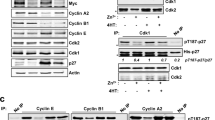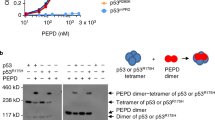Abstract
The p53 tumor suppressor gene belongs to a multigene family that includes two paralogues, p63 and p73. p73α has common activities with p53, such as DNA binding and transactivation, and can thus activate the transcription of p53-responsive genes. Using the adenoviral system, we report that an overexpression of either wt-p73α or one of the two transcriptional inactive mutants, ΔNp73α or p73αR292H, induces an accumulation of the endogenous wt-p53 expressed in the three transformed cell lines, SK-N-SH, MCF-7 and U-2OS, without stimulating the p53 gene transcription. p73-mediated accumulation of p53 protein coincides with an increase of p53-target gene expression in cells expressing either wt-p73α or the transcriptional inactive mutant p73αR292H, but not ΔNp73α that encodes a dominant-negative mutant of both p73 and p53. The fact that an ectopic expression of p73αR292H leads to both accumulation of p53 and stimulation of p53 target gene expression strongly suggests that p73α is able to induce activation of p53. This was confirmed by showing that p73αR292H no longer stimulated Waf1/p21 expression in MCF7/R-A1 cells that expressed a transcriptional inactive mutant of p53. We thus conclude that p73α protein was able to both stabilize and activate wt-p53 protein, independent of the p73α transcriptional activity.
This is a preview of subscription content, access via your institution
Access options
Subscribe to this journal
Receive 50 print issues and online access
$259.00 per year
only $5.18 per issue
Buy this article
- Purchase on Springer Link
- Instant access to full article PDF
Prices may be subject to local taxes which are calculated during checkout




Similar content being viewed by others
References
Balint E, Bates S and Vousden KH . (1999). Oncogene, 18, 3923–3929.
Cai Z, Korner M, Tarantino N and Chouaib S . (1997). J. Biol. Chem., 272, 96–101.
Chen J, Marechal V and Levine AJ . (1993). Mol. Cell. Biol., 13, 4107–4114.
Drané P, Bravard A, Bouvard V and May E . (2001). Oncogene, 20, 430–439.
Drané P, Leblanc V, Miro-Mur F, Saffroy R, Debuire B and May E . (2002). Cell Death Differ., 9, 527–537.
Fillippovich I, Sorokina N, Gatei M, Haupt Y, Hobson K, Moallem E, Spring K, Mould M, McGuckin MA, Lavin MF and Khanna KK . (2001). Oncogene, 20, 514–522.
Flores ER, Tsai KY, Crowley D, Sengupta S, Yang A, McKeon F and Jacks T . (2002). Nature, 416, 560–564.
Grob TJ, Novak U, Maisse C, Barcaroli D, Luthi AU, Pirnia F, Hugli B, Graber HU, De L, V, Fey MF, Melino G and Tobler A . (2001). Cell Death Differ., 8, 1213–1223.
Irwin MS and Kaelin WG . (2001). Cell Growth Differ., 12, 337–349.
Jost CA, Marin MC and Kaelin Jr WG . (1997). Nature, 389, 191–194.
Kaghad M, Bonnet H, Yang A, Creancier L, Biscan JC, Valent A, Minty A, Chalon P, Lelias JM, Dumont X, Ferrara P, McKeon F and Caput D . (1997). Cell, 90, 809–819.
Kartasheva NN, Contente A, Lenz-Stoppler C, Roth J and Dobbelstein M . (2002). Oncogene, 21, 4715–4727.
Levrero M, De Laurenzi V, Costanzo A, Gong J, Wang JY and Melino G . (2000). J. Cell Sci., 113, 1661–1670.
May P and May E . (1999). Oncogene, 18, 7621–7636.
Mills AA, Zheng BH, Wang XJ, Vogel H, Roop DR and Bradley A . (1999). Nature, 398, 708–713.
Nakagawa T, Takahashi M, Ozaki T, Watanabe K, Todo S, Mizuguchi H, Hayakawa T and Nakagawara A . (2002). Mol. Cell. Biol., 22, 2575–2585.
Stiewe T, Theseling CC and Putzer BM . (2002a). J. Biol. Chem., 277, 14177–14185.
Stiewe T, Zimmermann S, Frilling A, Esche H and Putzer BM . (2002b). Cancer Res., 62, 3598–3602.
Vossio S, Palescandolo E, Pediconi N, Moretti F, Balsano C, Levrero M and Costanzo A . (2002). Oncogene, 21, 3796–3803.
Yang A, Kaghad M, Caput D and McKeon F . (2002). Trends Genet., 18, 90–95.
Yang A, Kaghad M, Wang Y, Gillett E, Fleming MD, Dotsch V, Andrews NC, Caput D and McKeon F . (1998). Mol. Cell, 2, 305–316.
Yang A, Walker N, Bronson R, Kaghad M, Oosterwegel M, Bonnin J, Vagner C, Bonnet H, Dikkes P, Sharpe A, McKeon F and Caput D . (2000). Nature, 404, 99–103.
Zeng X, Chen L, Jost CA, Maya R, Keller D, Wang X, Kaelin Jr WG, Oren M, Chen J and Lu H . (1999). Mol. Cell. Biol., 19, 3257–3266.
Zhu JH, Nozell S, Wang J, Jiang JY, Zhou WJ and Chen XB . (2001). Oncogene, 20, 4050–4057.
Acknowledgements
We are grateful to Drs Jean Bénard and Sétha Douc-Rasy for communicating their data before publication. We thank Dr Daniel Caput (Sanofi Recherche) for p73α constructs, Dr Salem Chouaib for providing MCF7/R-A1 cells, Dr David Lane for providing DO-7 hybridoma, and Drs Henry Neel, Jacques Piette and Vincent Maréchal for their gift of antibodies directed against hMDM2. This work was supported by a grant from ARC (Association pour la Recherche sur le Cancer). Anne Meiller was supported by a fellowship from ‘Electricité de France’ and Francesc Miro-Mur by a fellowship from ‘Fondation pour la Recherche Médicale’.
Author information
Authors and Affiliations
Corresponding author
Rights and permissions
About this article
Cite this article
Miro-Mur, F., Meiller, A., Haddada, H. et al. p73α expression induces both accumulation and activation of wt-p53 independent of the p73α transcriptional activity. Oncogene 22, 5451–5456 (2003). https://doi.org/10.1038/sj.onc.1206538
Received:
Revised:
Accepted:
Published:
Issue Date:
DOI: https://doi.org/10.1038/sj.onc.1206538



